
Jacob Isaackszoon van Ruisdael stands as one of the most significant and influential figures of the Dutch Golden Age of painting. Active during the 17th century, a period of extraordinary artistic flourishing in the Netherlands, Ruisdael dedicated his immense talent primarily to landscape painting. He was not only a painter but also a skilled draughtsman and etcher, leaving behind a body of work celebrated for its evocative power, technical brilliance, and profound sensitivity to the natural world. His art captured the essence of the Dutch landscape while often imbuing it with a deeper, almost spiritual resonance, securing his place as a pivotal artist whose influence would extend far beyond his own time and borders.
Early Life and Artistic Formation
Born in Haarlem, a vibrant center for art in the Dutch Republic, likely in 1628 or 1629, Jacob van Ruisdael emerged from an environment steeped in artistic activity. His father, Isaack van Ruisdael, worked as a frame maker, art dealer, and possibly a painter himself, providing young Jacob with an early immersion in the visual arts trade. It is plausible that Jacob received his initial training from his father, absorbing the fundamentals of craft and composition within the family workshop.
Further shaping his nascent talent was the presence of his uncle, Salomon van Ruysdael. Salomon was already an established and respected landscape painter in Haarlem, known for his tranquil river scenes and tonal atmospheric effects. While the exact nature of their pedagogical relationship remains undocumented, Salomon's success and artistic approach undoubtedly served as a significant example and potential source of guidance for his nephew. Jacob's early works show an affinity with the Haarlem landscape tradition, also absorbing influences from artists like Cornelis Vroom, known for his detailed woodland scenes.
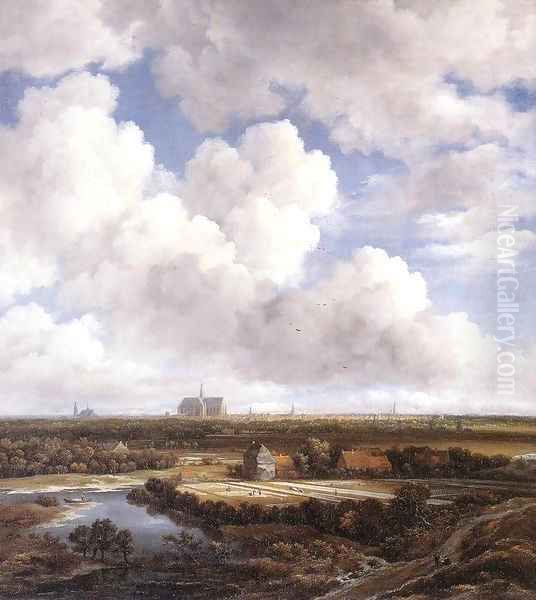
Ruisdael's formal entry into the professional art world is marked by his acceptance into the Haarlem Guild of Saint Luke in 1648. Membership in the guild was essential for artists wishing to practice independently, sell their work, and take on pupils. This milestone signified his recognition as a competent master painter, ready to embark on his own artistic path. His earliest dated works, from around 1646, already display remarkable skill and a distinct artistic personality, focusing on the local dune landscapes, woods, and villages around Haarlem.
Travels and Artistic Development
Around 1650, seeking broader horizons and new motifs, Jacob van Ruisdael undertook significant travels. A particularly influential journey took him, possibly in the company of his friend and fellow artist Nicolaes Berchem, eastward towards the Dutch-German border region near Bentheim. Berchem, known for his Italianate landscapes often populated with pastoral figures and animals, provided a contrasting artistic temperament, though their direct collaboration often involved Berchem adding figures to Ruisdael's landscapes.
This expedition exposed Ruisdael to more dramatic and varied scenery than the relatively flat terrain around Haarlem. He encountered rolling hills, dense forests, medieval castles like Bentheim Castle perched dramatically on its rocky outcrop, and rushing streams or waterfalls. These new visual experiences profoundly impacted his art, introducing a greater sense of monumentality and a more rugged, sometimes even wild, aspect of nature into his repertoire. Motifs such as Bentheim Castle and Scandinavian-inspired waterfalls, possibly influenced by the works of Allart van Everdingen who had travelled to Norway and Sweden, became recurring themes in his subsequent paintings.
Seeking the larger market and patronage opportunities of the Dutch Republic's thriving commercial hub, Ruisdael relocated to Amsterdam around 1655 or shortly thereafter. He gained Amsterdam citizenship in 1659, indicating his intention to establish himself permanently in the city. Amsterdam remained his base for the rest of his life, and it was during his Amsterdam period that he produced many of his most famous and ambitious works, including expansive city views, complex forest interiors, and powerful seascapes.
Artistic Style and Dominant Themes
Jacob van Ruisdael's artistic style is characterized by a remarkable synthesis of detailed realism and profound emotional expression. He possessed an extraordinary ability to observe and render the specifics of the natural world – the gnarled bark of an ancient oak, the texture of sandy soil, the play of light on water, the intricate structure of clouds. His trees, in particular, are often rendered with such individuality that they feel like portraits, their leaves sometimes painted with thick impasto to convey texture and vitality.
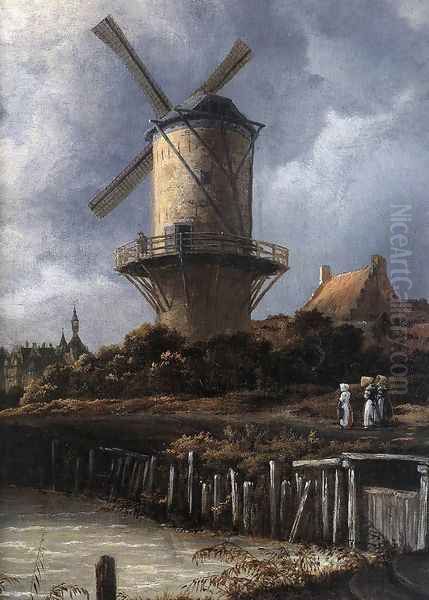
Central to Ruisdael's art is his mastery of light and shadow. He used light not merely for illumination but to create mood, drama, and focus. Sunlight might break dramatically through stormy clouds, spotlighting a distant field or windmill, or filter softly through a dense forest canopy, creating patterns of dappled light on the woodland floor. His skies are rarely passive backdrops; they are dynamic entities, filled with carefully observed cloud formations that contribute significantly to the overall atmosphere, whether serene or turbulent.
His thematic range was exceptionally broad for a landscape specialist of his time. He painted the familiar Dutch countryside with its windmills, canals, and bleaching fields, but also ventured into more dramatic territory with his forest scenes, waterfalls, seascapes, and winter landscapes. He depicted panoramic views, often taken from a high vantage point, showcasing the expansive flatness of the Dutch terrain under vast, expressive skies. Ruins, whether of castles or humble cottages, and cemeteries appear in his work, often evoking a sense of transience and the passage of time.
While deeply rooted in observation, Ruisdael's landscapes often transcend mere topographical accuracy. There is frequently a palpable mood, sometimes melancholic or contemplative, sometimes awe-inspiring. This romantic sensibility, an emphasis on the emotional power of nature, distinguishes his work. He was innovative in his choice of subjects, being among the first Dutch artists to make watermills and dramatic waterfalls central themes. His compositions are carefully constructed, often using strong diagonal lines or framing devices like trees to lead the viewer's eye into the scene and enhance its depth and impact. His typical color palette favored rich greens, earthy browns, and cool grays and blues, contributing to the often solemn and majestic tone of his paintings.
Key Representative Works
Among Ruisdael's extensive oeuvre of approximately 700 paintings, several stand out as iconic representations of his style and thematic concerns.
View of Haarlem with Bleaching Grounds (c. 1670-1675): This panoramic masterpiece, housed in the Rijksmuseum, Amsterdam, exemplifies his ability to capture the vastness of the Dutch landscape under an immense sky. From a high dune, the viewer looks out over the bleaching fields (where linen was laid out to be whitened by the sun) towards the city of Haarlem, dominated by the imposing Grote Kerk (St. Bavo's Church). The interplay of sunlight and cloud shadow across the landscape creates a dynamic and atmospheric effect, celebrating both nature and human industry.
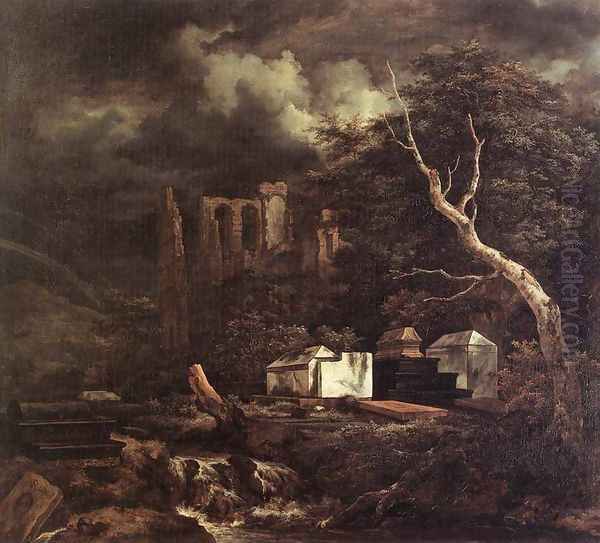
The Windmill at Wijk bij Duurstede (c. 1670): Also in the Rijksmuseum, this painting is one of the most famous depictions of a windmill in art history. The monumental mill stands silhouetted against a dramatic, cloud-filled sky, dominating the low horizon. Its powerful presence, combined with the turbulent water and brooding sky, lends the scene an air of quiet grandeur and resilience, often interpreted as a symbol of Dutch strength and perseverance.
The Jewish Cemetery (c. 1655-1660): Existing in two main versions (Detroit Institute of Arts and Gemäldegalerie Alte Meister, Dresden), this work is perhaps Ruisdael's most overtly symbolic and emotionally charged painting. It depicts tombs in the Beth Haim cemetery at Ouderkerk aan de Amstel, set within a dramatic, somewhat imaginary landscape featuring ruins, a rushing stream, storm-blasted trees, and a rainbow arching through a turbulent sky. The painting is widely interpreted as an allegory of transience, decay, and the hope of resurrection, reflecting on themes of life, death, and faith.
Bentheim Castle (various versions, e.g., c. 1653): Ruisdael painted Bentheim Castle numerous times, captivated by its dramatic setting. These works, often showing the castle perched high on its rocky hill surrounded by rugged woodland, showcase the impact of his travels to the German border. They represent a departure from the typical flat Dutch scenery, introducing a sense of the sublime and the picturesque.
Waterfall Paintings (various, 1660s): Inspired either by Allart van Everdingen's depictions of Scandinavian scenery or by his own travels, Ruisdael painted numerous scenes featuring powerful waterfalls cascading over rocks amidst dense forests. These works emphasize the untamed power and dynamic energy of nature, often carrying a sense of awe and romantic drama.
Forest Scenes (various, e.g., The Marsh in a Forest, c. 1660s): Ruisdael was a master of the woodland interior. His forest scenes depict towering trees, often ancient and weathered, dense undergrowth, stagnant pools, and filtered light. They convey a sense of solitude, mystery, and the enduring life cycle of nature, sometimes with a melancholic undertone.
Winter Landscapes (various, e.g., Winter Landscape, c. 1670): Ruisdael also excelled at capturing the specific atmosphere of winter. His winter scenes often depict snow-covered ground, frozen waterways with skaters, and bare trees under cold, gray skies, evoking the quiet stillness and sometimes harsh beauty of the season.
Collaborations and Contemporaries
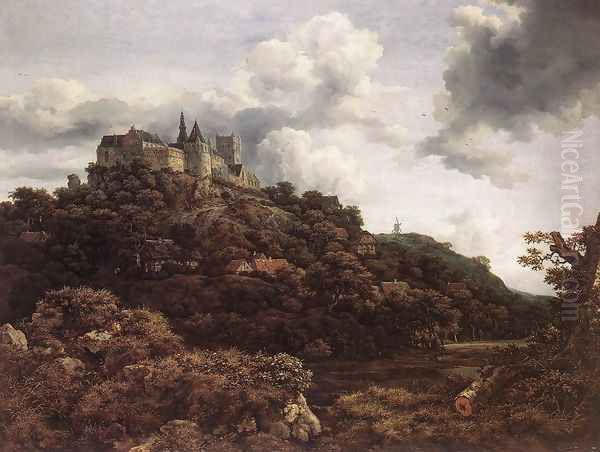
While Jacob van Ruisdael developed a highly individual style, he was not isolated from the bustling art scene of the Dutch Golden Age. His most direct artistic relationship was likely with his uncle, Salomon van Ruysdael, whose influence is discernible in Jacob's early works. Though Jacob soon surpassed his uncle in complexity and dramatic power, the family connection provided a foundational link to the established landscape tradition.
He actively collaborated with other artists, most notably Nicolaes Berchem. Berchem, along with other painters like Adriaen van de Velde and Philips Wouwerman, sometimes added figures and animals (known as "staffage") to Ruisdael's landscapes. This was a common practice at the time, allowing specialists to combine their skills. The journey Ruisdael undertook with Berchem around 1650 further cemented their professional connection.
Ruisdael's work also shows an awareness of, and dialogue with, other leading landscape painters. The influence of Allart van Everdingen is evident in Ruisdael's adoption of Scandinavian motifs like waterfalls and pine trees. He would have been familiar with the works of earlier Dutch landscape pioneers like Jan van Goyen and Esaias van de Velde, as well as contemporaries like Aelbert Cuyp, known for his luminous, Italianate scenes, which offered a different, sunnier vision of the Dutch countryside compared to Ruisdael's often more dramatic or introspective approach. While perhaps not a direct influence, the classical landscapes of artists like Claude Lorrain and Nicolas Poussin, known through prints, may have informed his sense of idealized composition, even as he remained grounded in Dutch realism.
Pupils and Enduring Legacy
Jacob van Ruisdael's impact extended directly through his teaching. His most famous and accomplished pupil was Meindert Hobbema. Hobbema worked closely with Ruisdael, possibly as an assistant in his studio during the early 1660s, and absorbed his master's style and techniques, particularly in the depiction of wooded landscapes and watermills. While Hobbema developed his own distinct style, often sunnier and less dramatic than Ruisdael's, the influence of his teacher is undeniable. Hobbema's later success, especially his famous The Avenue at Middelharnis, ensured the continuation of the Ruisdael tradition.
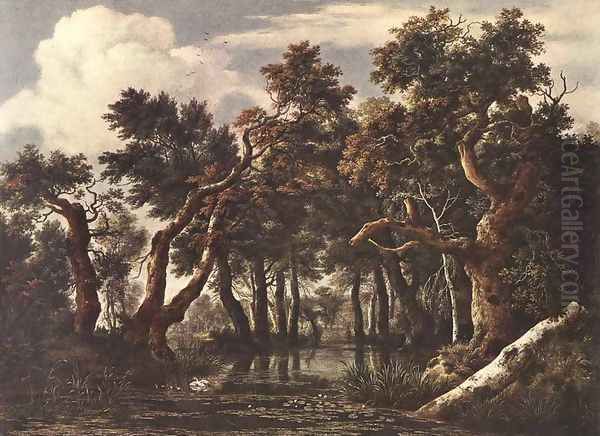
Beyond his direct pupils, Ruisdael's influence on subsequent generations of artists was profound and widespread. In the 18th century, his work was admired, but it was during the rise of Romanticism in the late 18th and early 19th centuries that his reputation soared. English landscape painters like Thomas Gainsborough and, most significantly, John Constable, deeply admired Ruisdael. Constable considered Ruisdael's naturalism and his ability to capture atmospheric effects exemplary, and Ruisdael's influence is palpable in Constable's own cloud studies and depictions of the English countryside. J.M.W. Turner also responded to the dramatic power of Ruisdael's seascapes and skies.
In France, the artists of the Barbizon School, working in the mid-19th century, looked back to Ruisdael and other Dutch Golden Age masters as precursors to their own commitment to painting realistic landscapes directly from nature. Artists like Théodore Rousseau and Jean-François Millet valued Ruisdael's honest depiction of rural scenery and his evocative use of light. Similarly, the Hudson River School painters in America, including Thomas Cole and Asher B. Durand, who sought to capture the grandeur of the American wilderness, found inspiration in Ruisdael's combination of detailed observation and sublime atmosphere.
Even later artists felt his resonance. Vincent van Gogh expressed admiration for Ruisdael's The Jewish Cemetery. Aspects of his compositional strength and his rendering of natural forms can be seen as precursors to elements explored by Impressionists like Claude Monet and even later modernists like Paul Cézanne and Wassily Kandinsky, who appreciated the underlying structure and expressive force in his landscapes.
Later Life and Reputation
Jacob van Ruisdael spent his productive later years in Amsterdam. Despite his artistic stature, he does not seem to have achieved the great financial success of some of his contemporaries. Records suggest a modest lifestyle. An intriguing but debated aspect of his biography is the claim, originating from his early biographer Arnold Houbraken, that Ruisdael studied and practiced medicine later in life, possibly obtaining a medical degree from Caen in France in 1676. While some documents support this, the extent of his medical practice remains unclear, and it seems unlikely to have supplanted his primary identity as a painter.
Jacob van Ruisdael never married and had no children. In his final years, his health may have declined. He died in March 1682. While he died in Amsterdam, he was buried, perhaps according to his wishes, in the Grote Kerk (St. Bavo's Church) in his native Haarlem, joining his father and uncle in rest.

His reputation has remained consistently high since the Romantic rediscovery of his work. He is universally regarded as the preeminent Dutch landscape painter of the Golden Age, admired for his technical virtuosity, his emotional depth, and his ability to elevate landscape painting to a level of profound artistic expression. His works are prized possessions of major museums worldwide, including the Rijksmuseum in Amsterdam, the National Gallery in London, the Metropolitan Museum of Art in New York, the Louvre in Paris, the Hermitage Museum in St. Petersburg, and the Hamburger Kunsthalle, ensuring his art continues to inspire and move viewers today.
Conclusion
Jacob van Ruisdael transformed Dutch landscape painting. Building upon the foundations laid by earlier artists, he infused the genre with unprecedented drama, emotional intensity, and technical refinement. His meticulous observation of nature, combined with his masterful handling of light, composition, and atmosphere, allowed him to create landscapes that were both convincingly real and deeply evocative. From the tranquil panoramas of Haarlem to the rugged waterfalls and solemn cemeteries, his work explored the diverse moods and enduring power of the natural world. Through his own art and his profound influence on generations of artists across Europe and America, Jacob van Ruisdael secured his legacy as a true master, whose vision continues to shape our appreciation of landscape in art.